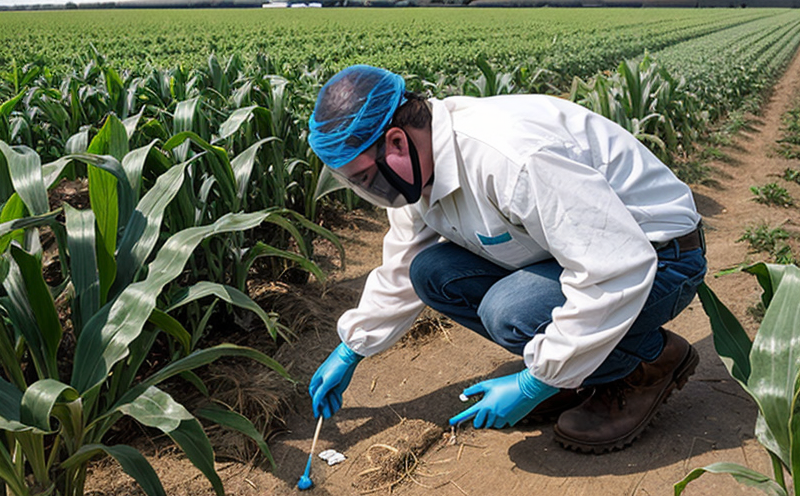Oxyfluorfen Residue Testing in Crops
Understanding and monitoring pesticide residues is a critical aspect of agricultural quality assurance. Among the various pesticides used, Oxyfluorfen, an herbicide belonging to the phenoxysulfonate class, plays a significant role in weed control for crops such as soybeans, cotton, and corn. This service focuses on testing for Oxyfluorfen residues in harvested crops to ensure compliance with regulatory standards.
Oxyfluorfen is designed to target broadleaf weeds and grasses through selective herbicidal action. Its effectiveness makes it a popular choice in agricultural practices. However, the potential for residue accumulation in harvested crops necessitates thorough testing to protect human health and environmental safety. Regulatory bodies such as the U.S. EPA set limits on pesticide residues to prevent adverse effects.
The primary objective of Oxyfluorfen residue testing involves identifying trace amounts of the herbicide in harvested crops through laboratory analysis. This process ensures that agricultural products meet stringent quality and safety standards, thereby protecting consumers from exposure to potentially harmful levels of pesticides. The testing method typically involves extracting residues using a solvent followed by quantification via chromatographic techniques.
Compliance with international standards like ISO 17025 for laboratory accreditation is crucial in ensuring reliable test results. This ensures that the analytical methods employed are accurate and consistent, allowing stakeholders to trust the findings. The testing process also involves specimen preparation steps such as sample collection, homogenization, and extraction using appropriate solvents.
Instrumentation plays a pivotal role in achieving precision during residue analysis. Chromatographic techniques like Liquid Chromatography-Mass Spectrometry (LC-MS) are commonly used for their sensitivity and specificity. These instruments allow for the detection of trace amounts of Oxyfluorfen, even at parts per billion levels.
The acceptance criteria for this service ensure that results fall within acceptable limits set by regulatory bodies. For instance, according to the EPA, the allowable limit for Oxyfluorfen in soybeans is 0.3 ppm (parts per million). Any residue above these specified thresholds would indicate a non-compliant sample.
Quality assurance in this service extends beyond just testing. It includes providing detailed reports that outline the methodology used, results obtained, and any deviations from acceptable limits. These reports are essential for regulatory compliance and can serve as valuable tools for quality management teams to make informed decisions regarding production processes.
The importance of accurate residue testing cannot be overstated in today's regulated agricultural environment. By adhering to stringent standards and employing advanced analytical techniques, laboratories like ours contribute significantly to maintaining the integrity of agricultural products. This not only ensures consumer safety but also upholds the reputation of producers who adhere to best practices.
Why It Matters
The presence of Oxyfluorfen residues in crops can have significant implications for both human health and environmental sustainability. Excessive exposure to pesticides like Oxyfluorfen has been linked to various health issues, including neurological effects and reproductive disorders. Ensuring that these residues do not exceed safe limits is paramount.
From an environmental perspective, the persistence of pesticides can lead to soil contamination and harm beneficial insects and wildlife. By conducting thorough residue testing, we help mitigate these risks, promoting a healthier ecosystem. This aligns with broader sustainability goals aimed at reducing the ecological footprint of agricultural practices.
Quality and Reliability Assurance
The quality and reliability of Oxyfluorfen residue testing are paramount in ensuring accurate results that meet regulatory requirements. Our laboratory adheres to strict protocols established by ISO 17025, which governs the performance capabilities and management systems of testing laboratories.
Our team of experts employs advanced analytical techniques such as Liquid Chromatography-Mass Spectrometry (LC-MS) to achieve precision in detecting even trace amounts of Oxyfluorfen. This instrumentation ensures consistent and reproducible results, enhancing the reliability of our findings.
We also provide detailed reports that include step-by-step methodologies used during testing, ensuring transparency for stakeholders. Compliance with international standards is a cornerstone of our quality assurance practices, guaranteeing that each test adheres to established guidelines set by regulatory bodies.
Environmental and Sustainability Contributions
The role of Oxyfluorfen residue testing in promoting environmental sustainability cannot be understated. By ensuring that crop residues do not exceed allowable limits, we contribute to reducing the ecological impact associated with pesticide use.
This service helps prevent soil contamination, which is a critical issue affecting long-term agricultural productivity and biodiversity. Additionally, by maintaining compliance with regulatory standards, we support sustainable farming practices that prioritize both environmental health and economic viability.
The findings from these tests can also inform farmers about the most effective application rates, helping to minimize unnecessary pesticide use. This not only reduces costs but also fosters a more responsible approach to agricultural practices, ultimately contributing to global sustainability efforts.





